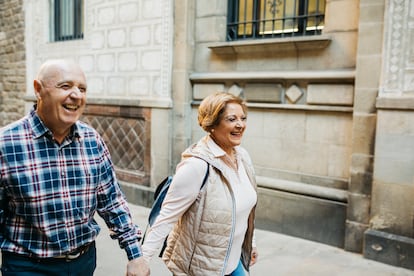Strolling as a way to disconnect from the stress of everyday life
The simple act of walking helps minimize anxiety. Urban spaces are a favorite setting in which to practice an activity of such growing popularity that clubs have sprouted to connect with the demand

Although remote work has allowed certain people to improve their work-life balance, it is still difficult to enjoy quality time when the workday ends. Because grocery shopping, taking the children to their swimming class and picking up that suit from the dry cleaners is another form of work, the one focusing on the home. To relieve the mental strain of everyday life, it is essential to disconnect, and in that sense, physical activity has always been an effective escape route.
Besides sports, more and more people are opting for the simple walk, not as an activity with which to gain muscle mass or reduce weight, but as a way to disconnect. So much so, that some gyms now offer walking clubs designed for walking in groups. One of these is the Walking Club of Club Metropolitan, a fitness chain with gyms in Spain and southern France. Mauro Carné, head of the events department, says the club aims “to offer a fitness experience in groups and take advantage of the benefits of joint training, in this case hiking or walking through urban environments.” This last remark is key, since the city is the new scenario that’s accessible to everyone, as opposed to nature walks which could pose more of a challenge. The walks offered by the sports center involve “low-intensity sessions of 45-60 minutes that are one of the best preventive therapies with which to work on different paces, slopes and descents, so that cardiovascular activity is stimulated.”
According to some surveys, walking has become more popular after the Covid pandemic. Studies show that walking is a more frequent activity among women and more popular after the age of 24. This growing interest has been picked up on by venues such as Club Metropolitan.
Technique, benefits and routine
Although it is a low-intensity activity, walking provides notable physical benefits, as long as its practice is continuous and not anecdotal. “If you walk regularly and efficiently, you soon improve the fitness of healthy adults by 10 to 30% compared to the starting level. Those who did not move around very much before starting to walk regularly will achieve better results in improving their physical condition,” explains Javier de Simón Brezmes, a physiotherapist from the ReAdapta Fisioterapia clinic in Burgos, in northern Spain. What’s more, in addition to helping us stay active, a walking routine can minimize certain muscle problems: “It helps improve physical condition, there is an improvement at the respiratory and cardiopulmonary level and it improves the use of energy by our muscles, so it is useful to combat a sedentary lifestyle.”
We all walk automatically, but contrary to what it may seem, walking also requires following a technique, just like doing squats or push-ups. The expert from ReAdapta Fisioterapia notes that one should walk with the “head in a neutral position, relaxed shoulders, elevated and open chest and gentle tension of the glutes to facilitate lumbopelvic stabilization.”
Lack of free time is the first barrier for those seeking to exercise, but walking is an easy alternative to introduce physical activity into the daily routine. One way to get started is to walk to work, if that is possible. For the benefits of walking to be optimal, “according to scientific evidence, the adequate daily amount of walking to maintain good health is one hour of continuous walking, burning 150 calories of additional energy and with a total of 8,000 to 10,000 steps,” says De Simón Brezmes.
Less sitting, better mental health
Something as simple as walking can also be an ideal activity to combat loneliness when done in company. WeWalk, a platform that organizes walking groups with a presence in 16 countries, offers different categories: senior walks, morning walks, Nordic walks, power walks and more. There are also corporate walks, designed as a group activity to encourage teamwork, and classes to obtain a certification as an expert walking coach.

Enjoying leisure time, improving physical fitness, combating loneliness — the benefits of a good walk seem almost limitless. Added to this is its potential as an antidote to certain mental health problems. Alberto Ramírez, a psychologist and CEO of MentalMadrid, explains it like this: “Physical exercise in general, be it walking, running or any type of strength activity, cardio and so on, greatly mitigates anxiety, stress and even depression. This is because we increase the production of serotonin and dopamine, which are hormones that help us reduce anxiety and combat depression and, therefore, there is a significant improvement in our physical and emotional system.”
Spending a good part of the day sitting not only causes muscle problems; a sedentary lifestyle also has a direct impact on the mind. Ramírez recalls that “the World Health Organization considers it the fourth risk factor for mortality in the world” and adds that “it has been observed that people who have a sedentary lifestyle have very low levels of BDNF [brain-derived neurotrophic factor], which is a protein with many brain functions. Among them, it prevents cognitive deterioration, increases concentration, improves blood flow in the brain and our attention span.” With the arrival of spring, what better time to go for a walk?
Sign up for our weekly newsletter to get more English-language news coverage from EL PAÍS USA Edition
Tu suscripción se está usando en otro dispositivo
¿Quieres añadir otro usuario a tu suscripción?
Si continúas leyendo en este dispositivo, no se podrá leer en el otro.
FlechaTu suscripción se está usando en otro dispositivo y solo puedes acceder a EL PAÍS desde un dispositivo a la vez.
Si quieres compartir tu cuenta, cambia tu suscripción a la modalidad Premium, así podrás añadir otro usuario. Cada uno accederá con su propia cuenta de email, lo que os permitirá personalizar vuestra experiencia en EL PAÍS.
¿Tienes una suscripción de empresa? Accede aquí para contratar más cuentas.
En el caso de no saber quién está usando tu cuenta, te recomendamos cambiar tu contraseña aquí.
Si decides continuar compartiendo tu cuenta, este mensaje se mostrará en tu dispositivo y en el de la otra persona que está usando tu cuenta de forma indefinida, afectando a tu experiencia de lectura. Puedes consultar aquí los términos y condiciones de la suscripción digital.
More information
Archived In
Últimas noticias
Most viewed
- Reinhard Genzel, Nobel laureate in physics: ‘One-minute videos will never give you the truth’
- Oona Chaplin: ‘I told James Cameron that I was living in a treehouse and starting a permaculture project with a friend’
- Pablo Escobar’s hippos: A serious environmental problem, 40 years on
- Why we lost the habit of sleeping in two segments and how that changed our sense of time
- Chevy Chase, the beloved comedian who was a monster off camera: ‘Not everyone hated him, just the people who’ve worked with him’











































